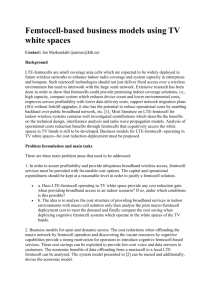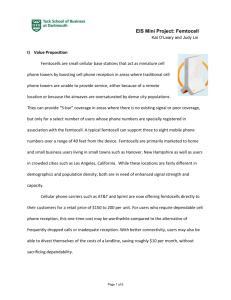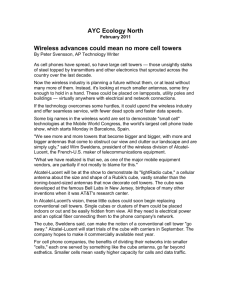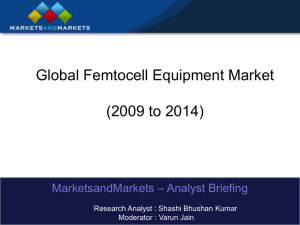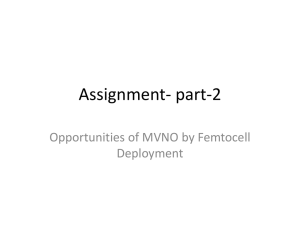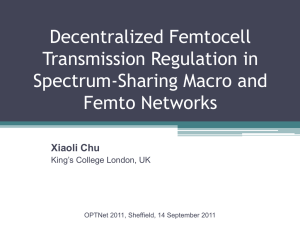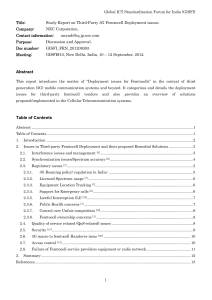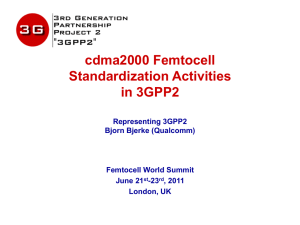Femtocells - Wireless networking, Signal processing and security Lab
advertisement
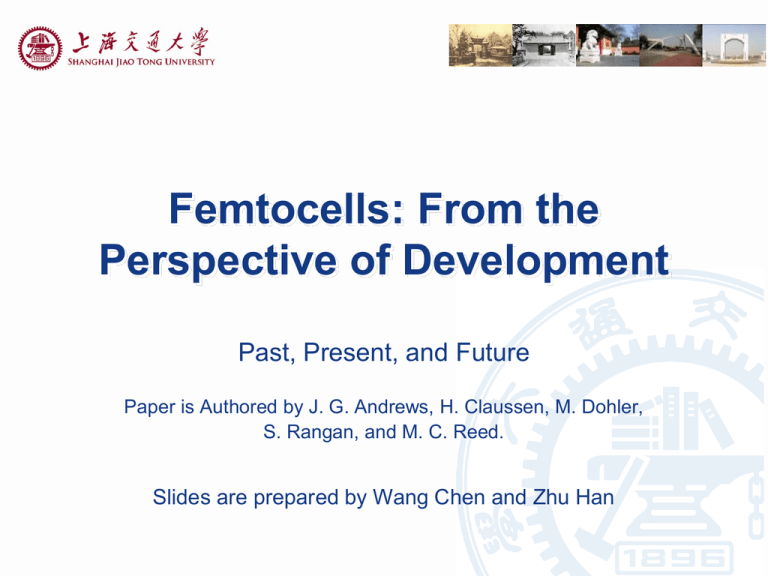
Femtocells: From the Perspective of Development Past, Present, and Future Paper is Authored by J. G. Andrews, H. Claussen, M. Dohler, S. Rangan, and M. C. Reed. Slides are prepared by Wang Chen and Zhu Han Contents 1. Overview of Femtocells 2. A Brief History of Femtocells 3. Femtocell Standardization 4. Femtocell Models 5. Overview of Key Challenges 1. Overview of Femtocells 2. A Brief History of Femtocells 3. Femtocell Standardization 4. Femtocell Models 5. Overview of Key Challenges Overview of Femtocells Femtocells are low-power wireless access points that operate in licensed spectrum to connect standard mobile devices to a mobile operator’s network using residential DSL or cable broadband connections. Overview of Femtocells Why femtocells is needed? ― Exponentially increasing wireless data traffic. Overview of Femtocells Why femtocells is needed? ― Data offload is real and measurable. Overview of Femtocells The key attributes of femtocells: ― Mature mobile technology ― Operating in licensed spectrum ― Generating coverage and capacity ― Using internet-grade backhaul ― At competitive prices ― Fully managed by licensed operators Question ― What is the difference from WIFI: some control ― What is different from microcell: backhaul Overview of Femtocells Vivek Dev, COO of Telefonica O2 Europe ― “Our Apple iPhone and flat rate data tariffs place huge capacity demands on our networks. Because so much of that usage is at home, femtocells could play a crucial role in underpinning the explosive growth of mobile broadband usage.” Frank Esser, CEO of SFR ― “3G femtocells answer the needs of our mobile-centric strategy 100 per cent.” 1. Overview of Femtocells 2. A Brief History of Femtocells 3. Femtocell Standardization 4. Femtocell Models 5. Overview of Key Challenges A Brief History of Femtocells Early Origins ― 1980s: • “Small cells” • Cellular repeaters or “boosters” ― 1990s: • A precursor to cellular picocells • An indoor femtocell-like solution (Southwest Bell and Panasonic) The birth of modern femtocells ― March, 1999 • Alcatel announced that they would bring to market a GSM home base station. ― 2002 • Motorola engineers in Swindon claimed to have built the first complete 3G home base station. A Brief History of Femtocells Development of modern femtocells ― 2003 • Chipset design company – picoChip – was demonstrating lowercost 3G chipsets. ― Mid-2004 • Ubiquisys and 3Way networks were formed in the UK to develop their own 3G cellular home base stations. ― 2007 • Products were demonstrated at the 3GSM conference. • The Femto Forum (www.femtoforum.org) was set up. ― August, 2008 • Commercial service was launched first by Sprint in the USA with their Airave CDMA offering. A Brief History of Femtocells Femtocell ecosystem A Brief History of Femtocells Femtocell products A Brief History of Femtocells Femtocell service deployments and commitments 1. Overview of Femtocells 2. A Brief History of Femtocells 3. Femtocell Standardization 4. Femtocell Models 5. Overview of Key Challenges Femtocell Standardization The governing body for standardization is the Femto Forum (www.femtoforum.org). Femtocell Standardization Mission: ― The mission is to advance the development and adoption of small cells for the provision of high-quality 2G/3G/4G coverage and services within residential, enterprise, public and rural access markets. 3G or 4G The Femto forum is active in two main areas: ― Standardization, regulation & interoperability; ― Marketing & promotion. Femtocell Standardization Working groups ― The marketing & promotion group ― The radio & physical layer group ― The networks & interoperability group ― The regulatory group Femtocell Standardization 3GPP standards for UMTS femtocells ― Interface between the femtocell (Home Node B - HNB) and the femto network gateway (HNB Gateway, HNB-GW) ― Security protocols to authenticate femtocell (HNBs) and secure communications across the un-trusted Internet ― Management protocols for “touch free” Operations, Administration, and Management (OA&M) of femtocells (HNB devices) Femtocell Standardization 3GPP2 standards for CDMA femtocells ― SIP/IMS-based 1x circuit services architecture ― Packet data architecture ― Security framework ― Enhancements to mobile devices to make them more femtoaware ― Foundations of femtozone services (Local IP Access and Remote IP Access) ― Femtocell management architecture Femtocell Standardization The need for LTE femtocells ― There is a limit to how many outdoor cell sites can be built; ― The spectrum available to any particular operator is limited; ― Cell site backhaul is expensive. LTE is the first cellular technology which will be able to take full advantage of femtocell. ― The large quantity of dynamically allocated time and frequency slots. Femtocell Standardization LTE architecture with deployed HeNB GW MME / S-GW MME / S-GW S1 S1 S1 S1 S1 S1 S1 S1 HeNB GW X2 E-UTRAN X2 S1 X2 S1 eNB eNB eNB HeNB HeNB HeNB 1. Overview of Femtocells 2. A Brief History of Femtocells 3. Femtocell Standardization 4. Femtocell Models 5. Overview of Key Challenges Femtocell Models Traditional hexagonal grid model ― Dozens of systems parameters can be modeled; ― Other-cell interference can be modeled simply; ― The results is sufficiently accurate to enable the evaluation of new proposed techniques. Multi-tiered cellular model ― Macrocells ― Picocells ― Femtocells ― Possibly further radiating elements Femtocell Models Link level modeling ― Channel status depend on a large number of factors • The propagation environment • Range & distance • Carrier frequency • Antenna placement • Antenna type The channel behavior of femtocell channels is similar to WiFi channels. ― Indoor, Winner II channel Femtocell Models System level model ― Multi-tiered networks models begin with a spatial point process to statistically model the base station locations of each tier. The simplest and best known such point process is the Poisson point process. ― The base station positions are all independent which allows substantial tools to be brought to bear from stochastic geometry. Femtocell Models System level model Femtocell Models Femtocell access control model ― Closed subscriber group (CSG) • Only pre-registered mobile users can use a certain femtocell. ― Open subscriber group (OSG) • Any mobile can use any femtocell or at least one that is “open”. Femtocell Models Femtocell network model ― Keep the grid model for macro base stations, drop femtocells “on top” of it, either randomly or in a deterministic fashion; ― Focus on a single femtocell dropped in the cellular network; ― Drop both the macrocells and femtocells randomly; ― Keep all the channel gains and possibly even the various peruser capacities general, without specifying the precise spatial model for the various base stations. 1. Overview of Femtocells 2. A Brief History of Femtocells 3. Femtocell Standardization 4. Femtocell Models 5. Overview of Key Challenges Overview of Key Challenges Technical challenges ― Interference scenario relationships Overview of Key Challenges Technical challenges ― Interference scenario relationships Overview of Key Challenges Technical challenges ― Interference level • With open-access and strongest cell selection, heterogeneous, multi-tiered deployments do not worsen the over all interference conditions or even change the SINR statistics. ― Interference of femtocell networks in practice • Unregistered mobiles cause significant interference to the femtocell; • The signaling for coordinating cross-tier interference may be logistically difficult. Overview of Key Challenges Technical challenges ― Interference coordination • 3G CDMA femtos • power control strategies • Reserving a “femto-free” band • 4G LTE femtos • Backhaul-based coordination • Dynamic orthogonalization • Subband scheduling • Adaptive fractional frequency reuse Overview of Key Challenges Technical challenges ― Spectrum: Femtocells can use any and all of these standardized bands • Opening up spectrum bands • Re-using existing bands • Spectrum and economic efficiencies • Innovation and competition Overview of Key Challenges Technical challenges ― Cell association and biasing • assign each user to the strongest base station signal it receives Overview of Key Challenges Technical challenges ― Cell association and biasing • Biasing: users are actively pushed onto small cells. Overview of Key Challenges Technical challenges ― Cell association and biasing • How to inform a biased user its channel assignment? • How much biasing is “optimal”? • The throughput/QoS metric of interest • How users and the uarious base stations are distributed in space • Traffic patterns in space-time • The amount of adaptivity and side information the mobiles and small cell base stations are able to exploit Overview of Key Challenges Technical challenges ― Mobility and soft handover • Femto-to-macro handover (outbound mobility) • Macro-to-femto handover (inbound mobility) • Possibly femto-to-femto handover ― The most difficult aspect of femtocell mobility • Femtocells are not typically directly connected into the core network • Femtocells are typically unable to share a RNC with a macrocell or other femtocells. Overview of Key Challenges Technical challenges ― Self-organizing networks (SON) • Femtocells must support an essentially plug-and-play operation ― Considerable research attention • Automatic channel selection • Power adjustment • Frequency assignment for autonomous interference coordination • Coverage optimization • The autonomous shutting down and waking up of base stations for power savings Overview of Key Challenges Economic and Regulatory Issues ― Operator Business Case • The cost of femtocells must be outweighed by the savings from offloading traffic from the macrocell networks; • Femtocells can be used to delay costly initial capital costs on macrocell network for operators deploying new 4G technology. ― Subscriber and ISP incentives • Subscribers and enterprises become responsible for installing the femtocells while private ISPs provide the backhaul. Overview of Key Challenges Economic and Regulatory Issues ― Femto vs. WiFi and Whitespace • WiFi: best-effort service; • Femto: managed service. ― Regulatory benefits • Improved access • Spectrum efficiency • Innovation and opportunity Overview of Key Challenges Economic and Regulatory Issues ― Regulatory aspects: • What is the impact of femtocells on spectrum licensing? • What about public health concerns? • What power levels do femtocells transmit? • How do operators stop users transmitting with femtocells on unauthorised frequencies or locations? • Could femtocells be “hacked”? • Do femtocells comply with existing standards? • How about the need to register base station locations? • What other regulatory issues should be considered? Conclusion Demand for cellular data services skyrockets Femtocell ― Organic plug-and-play deployment ― Highly democratic cost ― Possible chaos to the network Forecast ― Dense femtocell deployment ― Economic and capacity benefit
